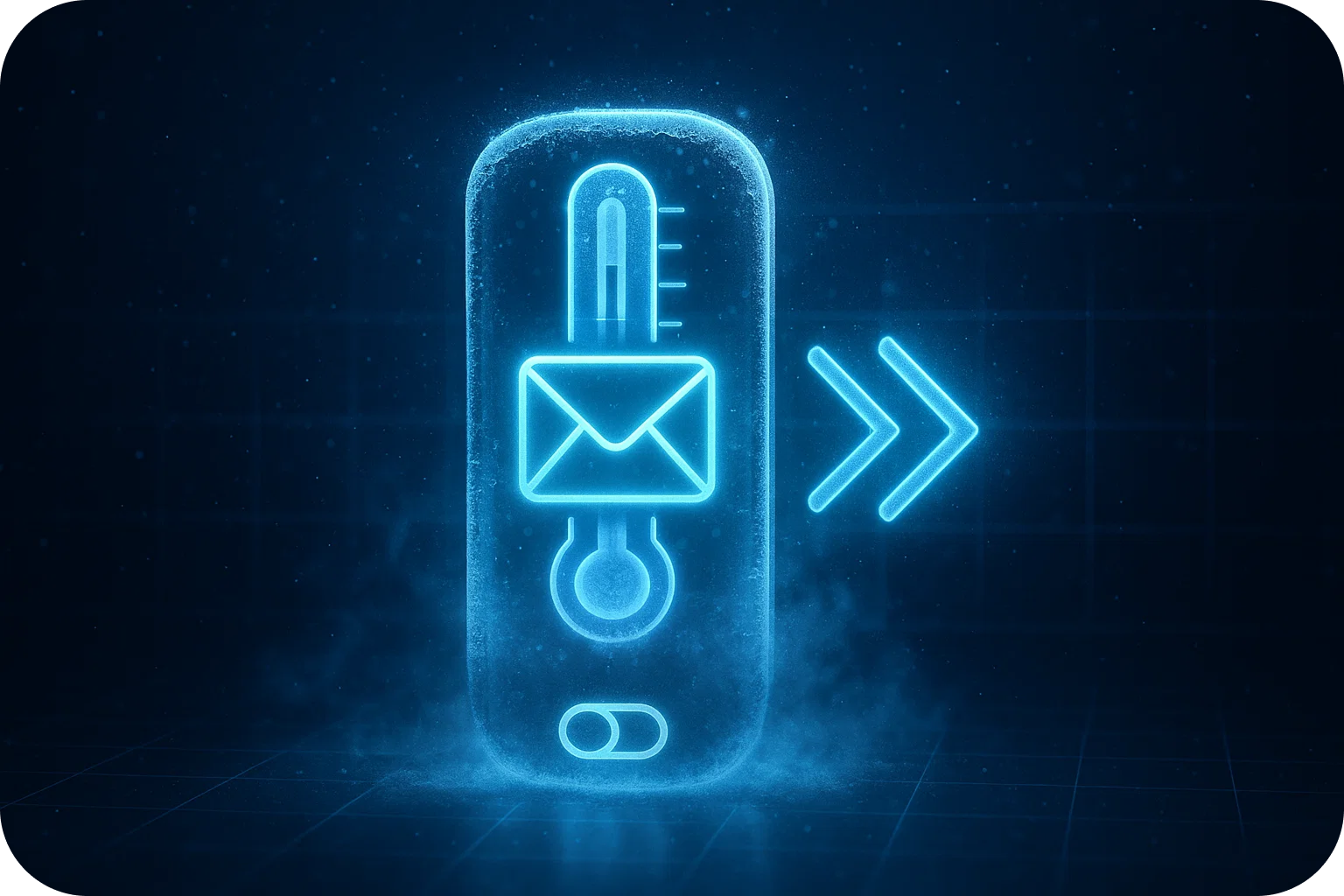The Reverse Warm-Up: Why You Should Stop Warming Up Your Inbox

For years, cold email professionals have followed the same playbook: create a new inbox, wait 3–4 weeks, send small volumes of low-engagement emails, and gradually increase your send volume. It sounds logical. It feels safe. But here's the uncomfortable truth: a traditional warm-up can actually damage your sender reputation instead of building it.
When you send thousands of emails to unengaged recipients during the warm-up phase, you're training email providers like Gmail and Outlook to flag your sender as low-quality. Those initial emails sit in spam folders, generate zero opens, and create negative engagement signals. ISPs notice. They remember. And by the time you're ready to scale, you've already built a reputation as a sender nobody wants to hear from.
The result? Lower deliverability rates, higher bounce rates, and campaigns that struggle to break through the noise even after weeks of "warming up."
Enter the Reverse Warm-Up: A Better Way
The reverse warm-up flips the traditional approach on its head. Instead of starting with weak engagement signals, you begin by building a genuine trust and positive reputation from day one.
Here's how it works:
- Start with high-quality, targeted outreach. Rather than sending to broad lists, your first emails go to warm prospects; people who've engaged with your content, visited your website, or fit your ideal customer profile perfectly.
- Prioritize engagement over volume. Send fewer emails to better-qualified recipients. Quality beats quantity when building sender reputation.
- Let positive signals accumulate. Opens, clicks, and replies create positive engagement metrics that ISPs reward. These signals compound, strengthening your reputation with every successful interaction.
- Scale strategically. Once you've established positive engagement patterns, gradually expand your outreach to broader audiences, but always maintaining quality standards.
The difference is profound. Instead of fighting an uphill battle against negative signals, you're building momentum with positive ones.
Why Sender Reputation Matters More Than You Think
Email providers use sophisticated algorithms to evaluate sender reputation. They look at:
- Engagement rates: Opens, clicks, and replies signal that recipients want your emails
- Bounce rates: High bounces indicate poor list quality or sender negligence
- Complaint rates: Spam complaints directly damage your reputation
- Authentication compliance: SPF, DKIM, and DMARC records prove you're a legitimate sender
- Sending consistency: Erratic sending patterns raise red flags
Traditional warm-up actually works against most of these factors. You're sending high volumes of low-engagement emails, which tank your engagement rates and bounce metrics. The reverse warm-up aligns with what ISPs actually reward: quality, consistency, and genuine recipient interest.
The Business Impact: Why This Matters for Your Bottom Line
For startups and sales teams, this isn't just about email theory; it's about revenue. Here's what reverse warm-up delivers:
Faster time to scale. You're not wasting 3–4 weeks building a negative reputation. You can begin meaningful outreach immediately while establishing positive signals.
Higher conversion rates. By targeting warm prospects first, your initial campaigns naturally generate better engagement and response rates. These early wins build momentum and provide social proof for your outreach strategy.
Lower cost per acquisition. When your emails actually reach inboxes and get opened, your cost per qualified lead drops significantly. You're not burning through budget on emails that never get seen.
Sustainable growth. A strong sender reputation compounds over time. Once established, it becomes harder to damage and easier to scale. You're building an asset, not fighting a liability.
Implementing Reverse Warm-Up: A Practical Framework
Week 1: Precision Targeting
Identify your absolute best-fit prospects, people who've shown genuine interest in your solution. Send 20–30 highly personalized emails to this group. Focus on relevance and authenticity over volume.
Week 2–3: Expand Thoughtfully
Analyze your engagement data. Which prospects opened? Clicked? Replied? Use these insights to refine your targeting and messaging. Expand to 50–75 emails, maintaining the same quality standards.
Week 4+: Scale With Confidence
Once you've established positive engagement patterns and proven your sender reputation, gradually increase volume. But never sacrifice quality. Continue monitoring engagement metrics and adjust your approach accordingly.
The Tools That Make Reverse Warm-Up Work
Implementing reverse warm-up requires the right infrastructure. You need:
- Reliable email delivery: A platform that ensures your emails reach inboxes with 98%+ deliverability rates
- Flexible inbox management: The ability to create and manage multiple inboxes and domains without complexity
- Authentic authentication: Proper SPF, DKIM, and DMARC setup to prove sender legitimacy
- Engagement tracking: Real-time visibility into opens, clicks, and replies to inform your strategy
The best platforms make this seamless, handling DNS configuration and deliverability optimization automatically so you can focus on what matters: crafting compelling outreach and building relationships.
Common Mistakes to Avoid
Don't abandon warm-up entirely. Reverse warm-up isn't about skipping the warm-up phase. It's about doing it intelligently. You still need to establish sender reputation; you're just doing it with quality instead of volume.
Don't ignore engagement metrics. If your initial outreach isn't generating opens or replies, pause and reassess. Your targeting or messaging might need adjustment before you scale.
Don't mix quality and quantity. The moment you start blasting low-quality lists, you undo all the positive reputation you've built. Consistency is key.
Conclusion
Cold email has evolved. The days of spray-and-pray warm-up are behind us. ISPs are smarter, filters are more sophisticated, and recipients are more discerning than ever.
The reverse warm-up isn't just a tactic; it's a mindset shift. It's recognizing that sender reputation is an asset worth protecting from day one. It's understanding that 50 emails to genuinely interested prospects will outperform 5,000 emails to random contacts.
For startups and sales teams operating with limited budgets and high expectations, this approach is a game-changer. You get faster results, better conversion rates, and a sustainable foundation for long-term growth.
Stop warming up your inbox the old way. Start building a real reputation from day one. Your deliverability and your revenue will thank you.
More articles
Get started now




%201.png)





